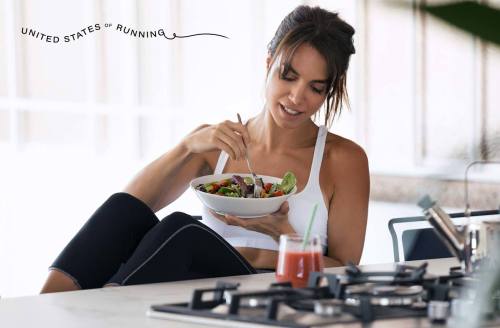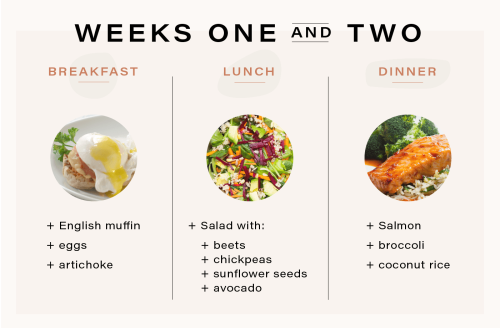Our editors independently select these products. Making a purchase through our links may earn Well+Good a commission
Your official 10K training meal plan, because something needs to power all those runs
Training for a 10K? Check out this meal plan for runners with tips from experts on what to eat each week to get you across the finish line.

In high school, I thought the pre-track meet spaghetti dinners were reason enough to take up running. Piling a plate high with noodles and beef-laden tomato sauce to fuel up for a whole two laps around the track (I ran the 800 meters) seemed like an idea I could get behind. You know what, better grab some garlic bread too for some extra carbs.
While I still run—and, hey, even a bit further than 800 meters now—my belief that endless carbs equals a better run is long gone. (Just like my high school metabolism.) But knowing exactly when, what, and how much to eat while training for a running event can be confusing—no matter how old you are. Like almost everything in life, it helps to have a plan, and if you’re gearing up for a 10K, this is it.
Here, sports and family medicine doctor Del Bolin, MD explains the macronutrient goals it’s important to hit in the weeks leading up to your race. To show you what that looks like, bRUNch Running co-founders Cortney Logan and Alexandra Weissner lay out what a sample day of eating could look like for each phase of your training.
Ready to get started? Keep reading for your 10K meal plan for runners.

Weeks 1 and 2
Macronutrient goals: According to Dr. Bolin, most training plans call for a milage increase of about 20 percent per week. “With this, you’ll want to up your protein an additional amount each week so that it ends up increasing to 10 percent by the [last] week,” he says. So if you’re used to protein typically being 20 percent of your overall diet, this is the time to up it to 22.5 percent, a small tweak. In other words: for the first part of training, your diet isn’t going to change that much.
Other food guidelines to keep in mind: Dr. Bolin emphasizes that it’s still important to maintain a balanced diet by eating plenty of veggies and healthy fats, too. He also says that when you eat is important, too. “You want to get some quick carbs within 20 minutes of your workout so it will help rebuild the glycogen in your muscles,” he says—although you don’t necessarily need to eat more carbs like you do protein. Most importantly, Dr. Bolin says to remember to stay hydrated before and after your runs.
Sample day of eating
Breakfast:
Weissner maximizes her hydration by dissolving a Nuun tablet ($24 for four tubes) into her morning glass of water, something she does for the other weeks of training as well. For breakfast, she recommends eggs, spinach, and artichoke, all drizzled with avocado oil, which she layers over an English muffin. This provides the protein Dr. Bolin says is so important (two eggs have 12 grams of protein), fiber from the veggies, and healthy fats from the eggs and avocado oil. If you’ve vegan, add some sunflower seeds on top of your English muffin and greens for protein; half a cup provides 13 grams.
Lunch:
For lunch, Weissner and Logan both recommend the same combo: protein and greens. One way they recommend getting it is in the form of a salad made with beets, chickpeas, spinach, sunflower seeds, and avocado.
Dinner:
This is the last chance of the day to give your body the protein it needs to recover. Weissner recommends salmon, broccoli, and coconut rice, which has protein and also some natural sugar (from the coconut milk used in the rice) your body may be craving after a run. She likes to add a droplet full of Dram Apothecary’s Sweetgrass Adaptogenic CBD Drops ($48) to her coconut rice, which she says helps her body relax.

Week 3
Macronutrient goals: Time to up your protein! It should be about 50.5 grams a day now, assuming you started with the recommended protein goal of 46 grams a day.
Other food guidelines to keep in mind: Just like before, Dr. Bolin says getting some quick carbs post-run and staying well hydrated all day are super important for your second week of training.
Sample day of eating
Breakfast:
Breakfast doesn’t always have to be a cooked meal. After completing a long run in the morning, Logan likes to refuel with a protein bar. Her pick is a Think! bar in either the chunky peanut butter ($32 for 20) or chocolate brownie crunch ($15 for 10). One bar has 20 grams of protein, which is a bit higher than the plate of eggs from your earlier training.
Lunch:
Spoiler alert: the protein and greens lunch combo from earlier in your training will make repeat appearances each week. This time around, Logan recommends a serving of chicken or steak with your favorite type of greens. If you’re vegetarian, switch the meat out for another protein source such as tofu or chickpeas, and add a side of cottage cheese for extra protein.
Dinner:
One of Logan’s favorite training dinners is a quick and simple grain bowl, which can be customized based on whether you eat meat or not. The key, of course, is to add in lots of veggies for fiber and get your go-to protein source in there. If you need help hitting that 50 grams for the day, add an egg.

Week 4
Macronutrient goals: New week, new daily protein goal. You should now aim to get 53 grams of protein a day.
Other food guidelines to keep in mind: As your milage continues to increase, Dr. Bolin emphasizes that getting that those quick post-run carbs are going to be even more important, so have your protein bar readily available or your post-run meal planned.
Sample day of eating
Breakfast:
To get a nice sized drop in the protein bucket, Weissner recommends a breakfast sandwich, made with an English muffin, eggs, ham, and avocado. This is your heartiest training breakfast yet and you’ll need it! If you’re vegetarian or vegan, sub out the eggs and ham for a veggie sausage option, like Morning Star’s sausage patties ($4 for six), which each have nine grams of protein.
Lunch:
Keep your salad game interesting by incorporating some grains into your bowl. Give it a Mediterranean spin by incorporating tuna (half a can has 20 grams of protein) and feta cheese in with the greens and grains for protein, will be a nice change from a typical chicken/tofu plus greens plus dressing rut virtually everyone gets stuck in at least once in their lives. Tuna also has magnesium, which help tired muscles recover from the inside out.
Dinner:
Weissner says chicken burrito bowls are one of her favorite recovery meals in the latter part of her training. She makes the chicken in her slow cooker and incorporates a salsa full of veggies such as tomatoes, peppers, and corn. (And avocado to top everything off, duh). If you don’t eat meat, sub out the chicken for black beans, another protein-rich food.

Week 5
Macronutrient goals: Okay, last week of training—this is it. Now, you’ve reached max protein consumption time with the goal of getting 55.5 grams a day.
Other food guidelines to keep in mind: This just in from Dr. Bolin: Hydrate, hydrate, hydrate. “Before and after your long runs, it’s helpful to hydrate with Gatorade, because the sugar will give your body some quick energy,” he says. If you plan on using any energy goos on race day, he says to experiment with them now. “You don’t want to be surprised with some sort of digestive upset when you’re running your 10K,” Dr. Bolin says. “Learn how your body will react in advance.” If you have a sensitive stomach, he says Swedish Fish could be a better way to go as they’re easy to digest. This is basically the one time a doctor is going to prescribe candy, so go for it!
Sample day of eating
Breakfast:
Weissner recommends something easy on the stomach and full of nutrients: oatmeal with nut butter. Veggies are going to be harder on the digestive system to process, not making them an ideal pre-run meal, but the oatmeal has adequate fiber in their place here. And the nut butter will give you the start of that protein you’ll need; two tablespoons has seven grams.
Mid-morning snack:
After your run (which will be the longest ones of your training), Weissner and Logan recommend reaching for a protein bar for extra fuel. Oh, and keep hydrating!
Lunch:
Weissner recommends using this week to empty the fridge of any leftovers that have built up. For example, put the chicken and salsa from the burrito bowls (or beans, if you went that route) on a bed of greens or repurpose them to go in a grain bowl.
Afternoon snack:
If you think you’re going to have trouble meeting your protein goal for the day, Weissner and Logan say to make a smoothie. (It also makes for a good post-run recovery snack.) Weissner likes to mix Blender Bombs Mint and Cacao Chip ($25 for 10) with one frozen banana, peppermint extract, spinach, and two tablespoons of nut butter.
Dinner:
To mix things up, Weissner loves a breakfast-for-dinner plate of protein pancakes. You can either buy a mix that’s already high in protein—like Birch Bender’s Protein Pancakes ($19 for three-pack), which has 16 grams of whey protein per serving—or you can add your own go-to protein powder into your own mix to customize it based on your preference and dietary needs.

What to eat on race day
When it comes to your day-of eating, Dr. Bolin has two big tips: Don’t try anything new, and eat at least an hour before the race starts, so your body has time to digest it. Weissner likes to have protein waffles topped with peanut butter the day of a race, which she eats two to three hours before go time. Logan prefers a protein bar, eggs, and a slice of toast with peanut butter a few hours before her run. If one of your Week Five pre-run meals made you feel amazing, chances are it will the day of the race, too. The key is to going with what works best for your body, so you’ll have your best race day ever.
Ready to start training? Here’s your five-week guide to training for a 5K or a 10K.










